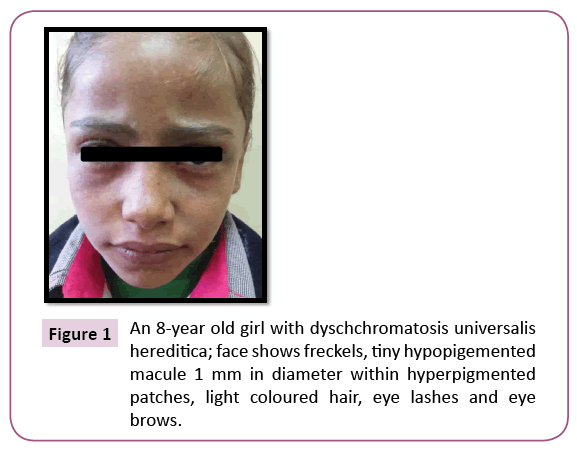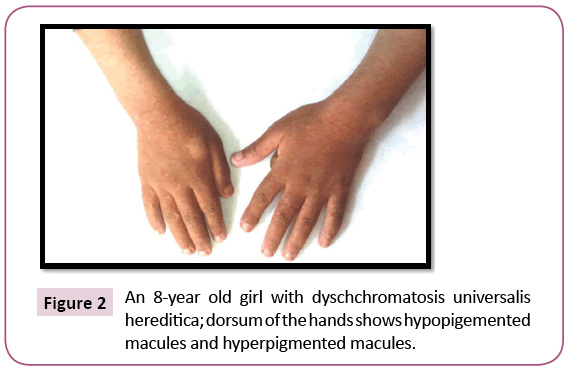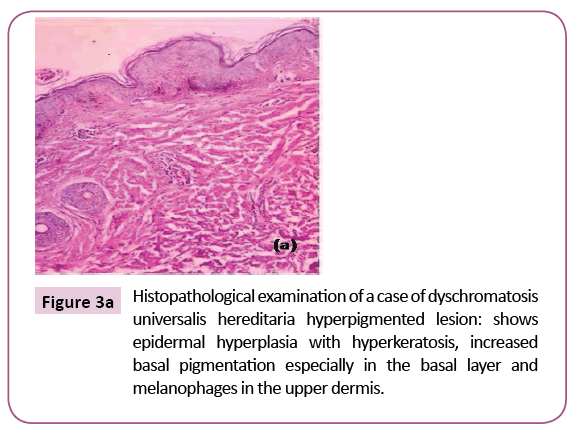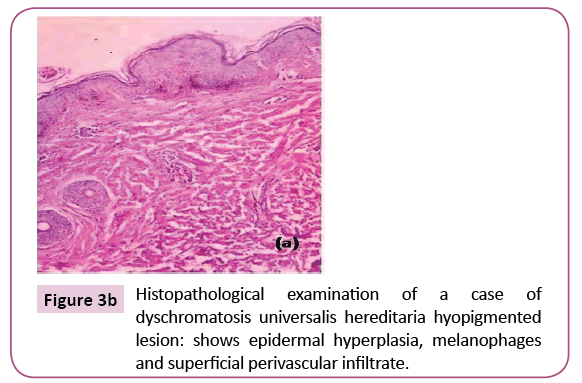Keywords
Dyschromatosis; Dyschromatosis universalis hereditaria
Introduction
Dyschromatoses are rare group of disorders that encompass conditions with both freckles like hyperpigmented and hypopigmented macules, many of which are small in size and irregular in shape. The spectrum of dyschromatoses includes dyschromatosis universalis hereditaria, dyschromatosis symmetrica hereditaria, acropigmentation of Dohi, and a segmental form called unilateral pigmentary dermatosis [1].
Case report
An 8 year old girl presented to our department complaining of ephelids in face, hyperpigmented and hypopigmented lesions in the cheeks, forehead, chin, back and extremities. Her parents reported that the lesions appeared during the first year of life and progressed over years. The patient has five siblings two of them have a similar condition while her parents were not affected.
Dermatological examination revealed dyschromatosis (diffuse hyperpigmented and with guttate hypopigmented macules) at back of hands, feet; and back ephelids in face, mainly in malar regions, light colored hair, eye brows and eye lashes (Figures 1 and 2).
Figure 1: An 8-year old girl with dyschchromatosis universalis hereditica; face shows freckels, tiny hypopigemented macule 1 mm in diameter within hyperpigmented patches, light coloured hair, eye lashes and eye brows.
Figure 2: An 8-year old girl with dyschchromatosis universalis hereditica; dorsum of the hands shows hypopigemented macules and hyperpigmented macules.
Apart from a history of associated hyperhidrosis, the patient showed no other abnormalities in palms, soles, nails and mucous membranes. Systemic examination revealed neither deafness, cataract, neurological abnormalities nor history of seizures.
Laboratory tests showed no abnormalities in blood picture, blood chemistry or amino acid metabolism.
Histopathological examination of a skin biopsy taken from the hyperpigmented lesions revealed epidermal hyperplasia with hyperkeratosis, increased basal pigmentation specially in the basal layer and melanophages in the upper dermis while histopathological examination of the biopsy from a hypopigmented lesion revealed epidermal hyperplasia, melanophages and superficial perivascular infiltrate (Figure 3a and 3b).
Figure 3a: Histopathological examination of a case of dyschromatosis universalis hereditaria hyperpigmented lesion: shows epidermal hyperplasia with hyperkeratosis, increased basal pigmentation especially in the basal layer and melanophages in the upper dermis.
Figure 3b: Histopathological examination of a case of dyschromatosis universalis hereditaria hyopigmented lesion: shows epidermal hyperplasia, melanophages and superficial perivascular infiltrate.
Discussion
Dyschromatoses are pigment disorders characterized by hyperchromic and hypochromic macules, taking a reticular pattern. Three main subtypes have been described; The generalised type; as in our case; or dyschromatosis universalis hereditaria was first described by Ichikawa and Hiraga in 1933 [2]. Skin lesions are usually present before 6 years of age with equal sex preponderance. The trunk and extremities are the dominant sites. Facial lesions were seen in almost 50% of affected individuals, but involvement of palms and soles is rare [2]. Although, the precise etiology of this disorder is not yet known, the dyschromatosis universalis hereditaria in an autosomal dominant disease but some cases are autosomal rescessive and the locus has been mapped to chromosome 6q24.2eq25.2 [3] and 12q21eq23.
In our case, the occurrence of affected brothers but unaffected parents could be explained by parental non-penetrance. Other explanations include autosomal recessive inheritance and germline mosaicism.
Dyschromatosis universalis hereditaris has been described to be associated with other systemic abnormalities. These include, small stature and high-tone deafness [4], abnormalities in erythrocyte, platelet, and tryptophan metabolism [5], epilepsy; insulin-dependent diabetes mellitus [6], photosensitivity along with neurosensory hearing defects; and ocular abnormalities [7]. To the best of our knowledge, this is the first reported case of dyschromatosis universalis hereditaria to be associated with light colored hair and hyperhidrosis.
The localized form of dyschromatosis; or dyschromatosis symmetrica hereditaria also called reticulate acropigmentation of Dohi. The lesions begin in the first to second decade and are classically non progressive. The skin findings are characterized by hypo- and hyper-pigmented macules on the dorsal and ventral aspects of the hands and feet, which may extend to the proximal portions of the limbs (knees and elbows) [8].
The segmental form of dyschromatosis; or Unilateral dermatomal pigmentary dermatosis in which the distribution is segmental. It is differentiated from segmental neurofibromatosis and partial unilateral lentiginosis by the mottled hyperpigmentation and hypopigmentation [9]. Lesions of dyschromatosis universalis hereditaria have to be differentiated from other inherited reticulate pigmentary disorders such as dermatopathia pigmentosa reticularis which is characterized by triad of reticulate hyperpigmentation, noncicatricial alopecia, and onychodystrophy, Naegeli-Franceschetti-Jadassohn syndrome which is characterized by complete absence of dermatoglyphics, reticulate hyperpigmentation, palmoplantar keratoderma, developmental anomalies of the teeth and hair, and dyskeratosis congenita which is characterized by reticulate pigmentation in neck, upper chest and upper arm, mucosal leukoplakia, dental and nail abnormalities [10]. The condition should be also differentiated from reticulate acropigmentation of Kitamura in which the hypopigmented macules are not present, but The lesions are in the form of slightly depressed, sharply demarcated black/brown macules localized to the dorsum of the hands and feet with small pits on the palms; and Dowling-Degos in which the lesions prevail at flexures, comedone-simile lesions are formed, and there are no hypochromic lesions [1]. Lesions of dyschromatosis symmetrica hereditaria have to be also differentiated from xeroderma pigmentosa because in both the disorders patients clinically show lesions in the photoexposed areas. However, in our patient, lesions were present in the unexposed sites as well. Moreover, the lesions did not show any atrophy or telangiectasia as seen in xeroderma pigmentosum. Other diseases in the differential diagnosis include vitiligo, dyschromic amyloidosis, residual leukoderma, and exposure to chemicals such as diphenylcyclopropenone and monobenzyl ether of hydroquinone. Yet, no such history of contact was present in our patient.
As the patient has light colored hair, This condition should be also differentiated from silvery hair syndrome including; Chediak- Higashi syndrome which is a rare autosomal recessive disorder characterized by mild pigment dilution (partial oculocutaneous albinism), silvery blond hair, bleeding tendencies, recurrent pyogenic infections, neurological defects. Griscilli syndrome which is also a rare autosomal recessive disorder characterized by reduced skin pigmentation, often regarded as partial albinism and silvery grey hair combined with immunodeficiency. And Elejalde Syndrome which is characterized by silvery hair and bronze skin color on sun-exposed areas, severe neurological imparment with normal immune system [11].
References
- Anstey AV (2010) Disorders of Skin Color. Rook's Textbook of Dermatology. Oxford: Wiley Blackwell 58: 20-22.
- Chang MW (2008) Disorders of hyperpigmentation. Elsevier publication.pp: 939-963.
- Xing QH, Wang MT, Chen XD, Feng GY, Ji HY, et al. (2003)A gene locus responsible for dyschromatosissymmetricahereditaria (DSH) maps to chromosome 6q24.2-q25.2. Am J Hum Genet73:377-382.
- Rycroft RJG, Calnan CD, Wells RS (1977) Universal dyschromatosis, small stature, high-tone deafness. ClinExpDermatol2:45-48.
- Foldes C, Wallach D, Launay JM, Chirio R (1988) Congenital dyschromia with erythrocyte, platelet, and tryptophan metabolism abnormalities. J Am AcadDermatol19:642-655.
- Schoenlaub P, Leroy JP, Dupre D, Chaboche C, Plantin P (1998) Universal dyschromatosis: a familial case. Ann DermatolVenereol125:700-704.
- Shono S, Toda K (1990) Universal dyschromatosis associated with photosensitivity and neurosensory hearing defect. Arch Dermatol126:1659-1660.
- Bolognia JL (2000) Disorders of hypopigmentation and hyperpigmentation. In: Harper J, Orange H, Prose N(eds.). Textbook of Pediatric Dermatology. United States: Blackwell Science. pp:868-870.
- Hara M,Kumasaka K, Tomita Y, Tagami H (1992)Unilateraldermatomalpigmentarydermatosis: A variant dyschromatosis. J Am AcadDermatol27:763-764.
- Sirinavin C, Trowbridge AA (1975)Dyskeratosiscongenita: Clinical features and genetic aspects. J Med Genet 12:339-354.
- Reddy RR, Babu BM, Venkateshwaramma B, Hymavathi CH (2011) Silvery Hair Syndrome in Two Cousins: Chediak-Higashi Syndrome vsGriscelli Syndrome, with Rare Associations. Int J Trichology3: 107-111.





